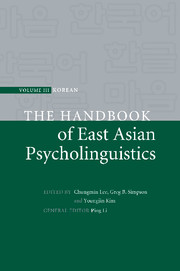Book contents
- Frontmatter
- Contents
- List of figures
- List of tables
- List of contributors
- Preface
- Introduction: Advances in Korean psycholinguistics
- Part I Language acquisition
- Part II Language processing
- 28 Visual processing of Hangul, the Korean script
- 29 English vowel spaces produced and perceived by Americans and Koreans
- 30 Morphological representation and processing of Sino-Korean words
- 31 The role of phonology in word recognition of Korean Hangul and Hanja
- 32 Lexical and sublexical processes in Korean word recognition
- 33 Prosody in sentence processing
- 34 Korean sentence processing
- 35 Sentence processing and memory representation in Korean
- 36 Understanding complex sentences: memory constraints and informational structure
- 37 ERP studies of Korean language processing: word-order effects
- 38 Inferences during discourse comprehension in Korean
- 39 Morpho-syntactic processing in Korean aphasics
- 40 Morpho-syntactic processing of Korean-speaking adults with Broca's aphasia
- 41 Comprehension deficits in Korean agrammatic aphasia
- 42 Developmental reading disorders in Korean
- 43 Individual differences in Korean language processing: context-dependent processing of skilled readers in word ambiguity resolution
- 44 A computational model of lexical and morphological processing in Korean
- References
- Name index
- Subject index
30 - Morphological representation and processing of Sino-Korean words
from Part II - Language processing
Published online by Cambridge University Press: 05 June 2012
- Frontmatter
- Contents
- List of figures
- List of tables
- List of contributors
- Preface
- Introduction: Advances in Korean psycholinguistics
- Part I Language acquisition
- Part II Language processing
- 28 Visual processing of Hangul, the Korean script
- 29 English vowel spaces produced and perceived by Americans and Koreans
- 30 Morphological representation and processing of Sino-Korean words
- 31 The role of phonology in word recognition of Korean Hangul and Hanja
- 32 Lexical and sublexical processes in Korean word recognition
- 33 Prosody in sentence processing
- 34 Korean sentence processing
- 35 Sentence processing and memory representation in Korean
- 36 Understanding complex sentences: memory constraints and informational structure
- 37 ERP studies of Korean language processing: word-order effects
- 38 Inferences during discourse comprehension in Korean
- 39 Morpho-syntactic processing in Korean aphasics
- 40 Morpho-syntactic processing of Korean-speaking adults with Broca's aphasia
- 41 Comprehension deficits in Korean agrammatic aphasia
- 42 Developmental reading disorders in Korean
- 43 Individual differences in Korean language processing: context-dependent processing of skilled readers in word ambiguity resolution
- 44 A computational model of lexical and morphological processing in Korean
- References
- Name index
- Subject index
Summary
Abstract
Sino-Korean words are Chinese words that have been borrowed into the Korean language over a long period of history. Currently representing over 70 percent of the entire Korean vocabulary, Sino-Korean words are typically two syllables in length and morphologically compound in structure. Behavioral studies have shown that although morphologically related Sino-Korean primes neither facilitate nor inhibit the processing of a target Sino-Korean word, orthographically related Sino-Korean primes tend to inhibit the recognition of a target word. Such findings are inconsistent with existing models for English and Chinese. Based on these Korean research findings, it is proposed that a level of morphological representations exists between word-form and semantic representation, and that there are strong inhibitory connections between word-form representations that share a given syllable in a particular word position. A number of related issues are also discussed, such as the representation of morphology within the mental lexicon, individual differences in terms of reading proficiency, semantic versus morphological relatedness, and the position of critical constituents.
Introduction
The Korean alphabet, or Hangul, consists of fourteen consonant and ten vowel letters. While each letter of Hangul represents a phoneme, it is more accurate to characterize the present Korean writing system as being morphophonemic in nature, rather than purely phonemic. In order to correctly spell a Korean word, it is necessary to consider both its phonological and morphological characteristics.
- Type
- Chapter
- Information
- The Handbook of East Asian Psycholinguistics , pp. 398 - 408Publisher: Cambridge University PressPrint publication year: 2009
- 7
- Cited by



